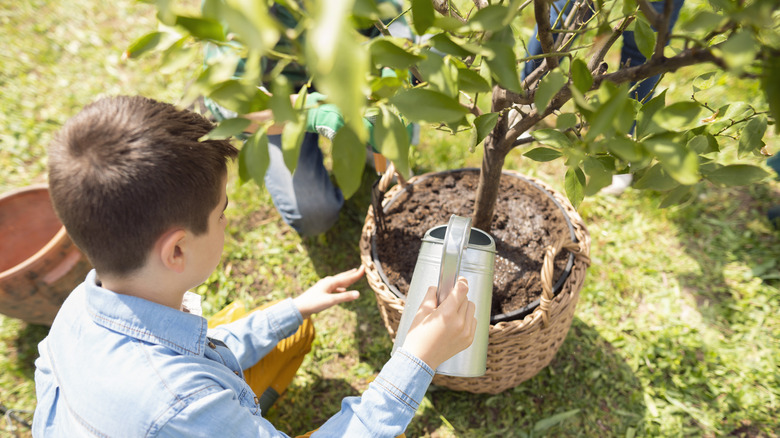Here's How To Grow Lemon Trees From Seed To Add Some Pucker To Your Life
Whether you want to plant them as a focal point in a perfectly manicured yard or you're just looking for a quirky pop of color in your cozy city apartment, lemon trees are a fun and rewarding addition to your home and garden. While you can buy a lemon tree or a dwarf version from a nursery and repot it or plant it outside, you absolutely can grow your own lemon tree from seeds. Yes, it might take longer to produce fruit than a tree bought from a nursery, but the result will be so rewarding as the years go by.
However, it might be best to manage your expectations before taking this project on. Growing a lemon tree from seed isn't as straightforward as it may seem. It could take 10-15 years for your seed-grown lemon tree to start producing fruit and even then, it may not look and taste the way you expect it to. What you will get to enjoy is the lovely smell it creates as it grows, as well as the satisfaction of knowing you grew something all on your own. If none of that stops you from wanting to grow a lemon tree of your own, it's time to prepare your seeds!
Prepare and plant your lemon seeds
Before you rush to grab all your garden tools in preparation for the hard work ahead, you need to do some prep work. If you know how to germinate seeds, you can start your lemon tree in your very own kitchen. Simply cut a lemon in half or quarters, depending on how many seeds you're hoping to get. Be careful not to knick any of them. Remove the seeds, place them in a bowl of water, and gently rinse them to remove any remaining pulp. If any of the seeds float in the bowl of water, that means they aren't viable and you should throw them out. Leave your seeds in water overnight to soak so the outer shells can soften.
The next day, use a nail clipper or a knife to clip the pointy ends of the seeds and easily peel off the outer shells. Plant the seeds 1 inch deep in quality potting soil in a container with good drainage at the bottom. You want your lemon seeds to retain moisture, but you want to make sure they're not sitting in a pool of water where bacteria can build up and put your plant at risk of disease. Cover your planted seeds in a transparent plastic bag and tie it tightly. Once your seedlings begin to grow, remove the cover and place them in a brightly lit area.
How to care for your lemon tree
Once your lemon tree is big enough to produce leaves, it can be moved outside in USDA zones 9 through 11. If you're in a cooler climate, you can continue growing your tree indoors in a bigger container. If planted in a container outdoors, bring your tree indoors when the seasons change and temperatures start to drop to avoid frost. Wherever you choose to put your lemon tree, make sure it's in a spot where it'll get a minimum of eight hours of full sun exposure. Use a fertilize that is suitable for citrus during the growing months. But don't be heavy-handed when fertilizing or watering. Wait for the top 3 inches of soil to dry before watering it again.
Your lemon tree might not be quick to branch out the way you like at first but you can prune the tip of the central shoot to give a good nudge. You can also prune your lemon tree in the shape you like as it continues to branch out to give it a manicured look. Your tree isn't immune to common pests and diseases that target plants. The pests to look out for include aphids, scale insects, and citrus leaf miners, but they can be combated by using neem oil on your plants.


